 |
| Ilford Pan 100 35mm film |
Ilford Pan 100 is a traditional cubic-type emulsion medium-speed black and white panchromatic film from Harman under the Ilford brand, which is complemented with a fast
Ilford Pan 400 film.
Ilford FP4 Plus and
HP5 Plus are Ilford's well-known traditional emulsion films in the same (or similar; see comments below) speed ratings; however, the Ilford Pan films have not been generally available in the UK. The
data sheet states:
The ILFORD range of PAN 100 and PAN 400
black and white camera films are not generally
distributed and sold worldwide, they are only
made available in selected markets.
The name, 'Pan', simply standing for
panchromatic, is indicative of the basic nature of these films (panchromatic is, of course, the 'P' in
FP4 and
HP5). Recently a number of UK retailers
have been stocking the films, which may represent a change of policy by Ilford in terms of market strategy for their particular products. I bought a number of rolls of Ilford Pan 100 at
Process Supplies Ltd - now my 'drop-in' shop in central London (on the closure of film photography shops, see my post
Seven Years On), where I noticed a display under the glass counter of the Pan films - despite these not being listed on their website.
There are some suggestions online that the Pan 100 and 400 films currently available are the old formulas of FP4 and HP5; there's an unattributed 'Ilford employee' quoted on
a thread on the Amateur Photographer forum given as stating: "They are based on FP4+ and HP5+ technology, but are produced to lower specifications and tolorances [sic]. While the quality is acceptable, these films are lower in quality than other ILFORD films." Having used the older version of FP4, before the 'Plus' iteration, I was able to compare times from the leaflet inside the box of FP4 with times given for Ilford Pan 100, and the times are different in all developers, some are close, but not the same. However, in some developers the times
are the same for the current version of FP4 Plus and Ilford Pan 100 (notably for the developers I used for this post, R09/Rodinal and Ilfotec LC29), with the important caveat that FP4 Plus is of course rated 125 ISO at box speed, one-third of a stop faster than the box speed of Pan 100 - not a great difference in sensitivity, but worth noting. It's also worth remarking that the Kentmere films, made by Ilford's parent company Harman, have been their low-price traditional films available in recent years, but these have different times from the Pan films. The data sheet referenced earlier states that the Pan 100 and 400 are available in 35mm and 120, but the sheet itself is dated March 2002; there are a
few posts online suggesting that the Pan films were discontinued some years ago; it may be that the production ceased for a period, and was then restarted for 35mm film only.
When researching Ilford Pan 100, I did not find any in-depth, serious reviews of the film online - there are, however, plenty of forum posts along the line of 'what is this film?' Incidentally, Pan 400 appears to be a bit more popular, or at least seems to come up more often than Pan 100, and in searches, there's a lot of results for Ilford Pan F - which is quite a different film altogether. Developing times for Pan 100 (and Pan 400) are
not listed on Ilford's
standard development chart listing their other Ilford-branded films (except Ortho Copy Plus); for this post I used the times printed inside the box, which are the same as those on the
Massive Dev Chart.
 |
| Ilford Pan 100 latitude test contact sheet |
For a latitude test, I shot a half roll of Ilford Pan 100 with the
Canon A-1. The first two rows on the contact sheet above were rated at exposure indexes of 25/50/100/200/400/800; the last row was shot at box speed, but with some bracketing. I developed the film in R09 One Shot, diluted 1+25 for 9 minutes at 20ºC. The contact sheet appears to show a swift falling off with underexposure; with scanning, it was possible to pull detail from the shadows (likewise with the highlights with overexposure) for a stop under without any difficulty, but with three stops there was very little detail there.
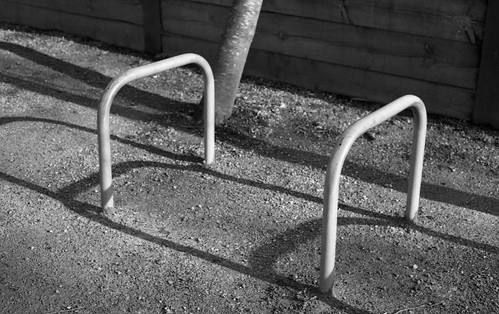 |
| Ilford Pan 100 one stop underexposed |
 |
| Ilford Pan 100 three stops underexposed |
With overexposure, the compression of the tonal range is problematic: the detail is all present, but the flattened tones are perhaps unattractive, and makes scanning more difficult.
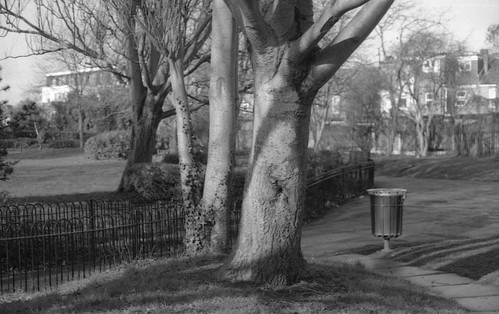 |
| Ilford Pan 100 two stops overexposed |
Departing from box speed, I shot some Ilford Pan 100 at 50, a one-stop pull. Developed in Ilfotec LC29, diluted 1+19 for 6m30s at 20ºC, the results
may show a slightly reduced contrast, although for most conditions, pull-processing is a compromise relied on less often, and so as a general rule, less critical than push-processing - I very rarely pull-process. However, in high-contrast situations, it may well be a useful corrective.
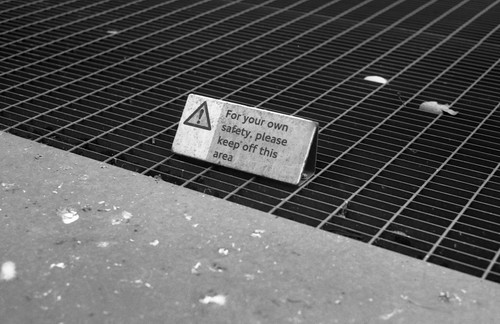 |
| Kiev-4 with Ilford Pan 100 at 50 |
Ilford's developing chart in the box also has times for a one-stop push to an exposure index of 200. I shot a roll with the
Kiev-4; however on the day I shot the film, I was not really shooting in 'normal' lighting conditions - the snow made for relatively high-contrast subjects, but the lighting was heavily overcast and grey. In addition, this one-stop test was mostly shot at end of afternoon as the light itself was fading. I developed this roll in Ilfotec LC29 diluted 1+19 for 9 minutes at 20ºC.
 |
| Kiev-4 with Ilford Pan 100, rated 200 |
The results from the latitude test were not as good as other films I've tested (my benchmark for a film that demonstrates especially good latitude is
Adox Silvermax 100), but I did want to try a two-stop push with Ilford Pan 100; rating it at 400 is not recommended by Ilford themselves. On the Massive Dev Chart there are a
couple of results for rating it at 400 (as well as 800 and 1600), but none in developers I habitually use. For a first test, I used Ilfotec LC29 diluted 1+19, and made an estimate at 14 minutes (in retrospect, this probably should have been more like 18 minutes, using a rule of thumb of a two-stop push needing 2.25x normal development). The results were mixed; with good, diffused light, as in the image below, this developing regime worked well enough.
 |
| Ilford Pan 100 at 400, developed in Ilfotec LC29, 1+19 for 14m at 20ºC |
However, with high contrast subjects, the lack of shadow detail was clear. In the first of the two images below, this matters less, but the landscape image underneath suffers: the bright but low angle of the sunlight casts deep shadows that are nearly featureless. Highlight detail (as in the clouds) is also difficult to retrieve (I also shot
some of this roll at night, further adding to the contrast).
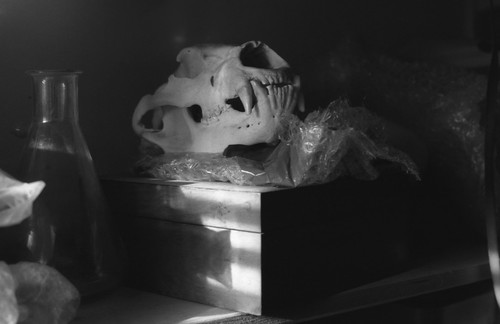 |
| Ilford Pan 100 at 400, developed in Ilfotec LC29, 1+19 for 14m at 20ºC |
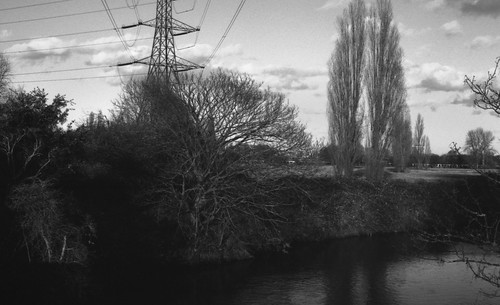 |
| Ilford Pan 100 at 400, developed in Ilfotec LC29, 1+19 for 14m at 20ºC |
In either case, I doubt that extending the development time to a full 18 minutes would have helped. Rather than assume that pushing Pan 100 to 400 to be a compromise hardly worth attempting, I tried a different tack:
stand development. Using R09 One Shot diluted to 1+150, I stand developed another roll of Pan 100 rated 400 for 3 hours (agitating on each hour interval). It's a method I have used with Ilford HP5 Plus previously and I've liked the results. The theory behind using such a high dilution of R09 is to reduce the contrast that accompanies push-processing; no doubt most of the development has occurred by the one-hour stage, but I wanted to give the shadow areas as much opportunity to develop as possible. The grain in the photographs developed in this way appears smoother than the push-processing in Ilfotec LC29, although of course the subject matter is not entirely comparable. Incidentally, both rolls shot at an exposure index of 400 were taken with the Canon A-1, which should eliminate the vagaries of metering, although lighting conditions were quite varied; further tests might be taken to refine this approach, but, in a pinch, a two-stop push with Pan 100 can produce acceptable results.
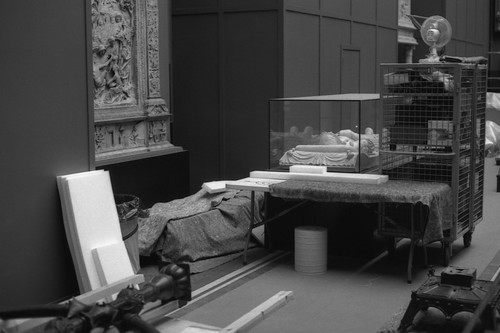 |
| Ilford Pan 100 rated 400, stand developed in RO9 diluted 1+150 for 3 hours |
Ilford Pan 100 is certainly not a good substitute for FP4 Plus - but it may be for Kentmere 100, if one is looking for a budget black and white film. The grain of Pan 100 does not appear as smooth as FP4 Plus, and, to my eye, it also has a different look: something about it reminds me somewhat of the Fomapan films, the pattern of the grain being more random and less evenly dispersed. The price, of course, is what is attractive about the Ilford Pan films: I bought my 36-exposure rolls of Pan 100 at £3.99 apiece, which is admittedly a little more expensive than Kentmere 100 (perhaps the extra twenty-something pence is for the Ilford name) - and it may of course be possible to find the film even cheaper elsewhere online.
 |
| Ilford Pan 100 shot with Agat 18K (half frame) |
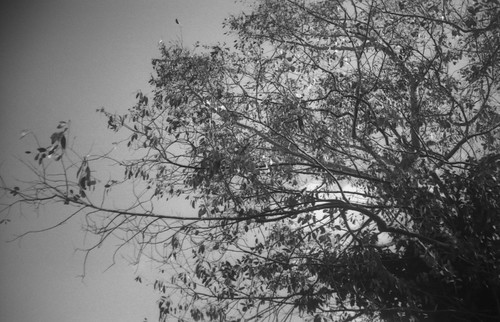 |
| Ilford Pan 100 shot with Halina 35X |
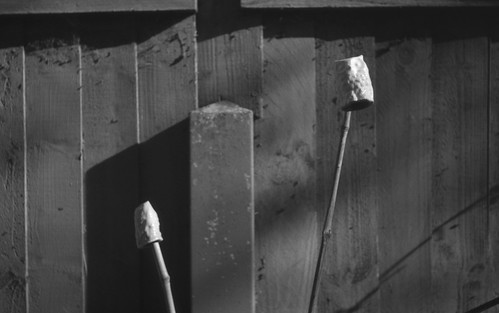 |
| Ilford Pan 100 shot with Praktica nova I |
 |
| Ilford Pan 100 shot with Voigtländer Vito IIa |
 |
| Ilford Pan 100 shot with Canon A-1 |
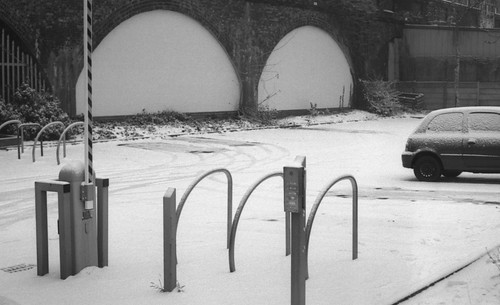 |
| Ilford Pan 100 shot with Kiev-4, rated 200 |
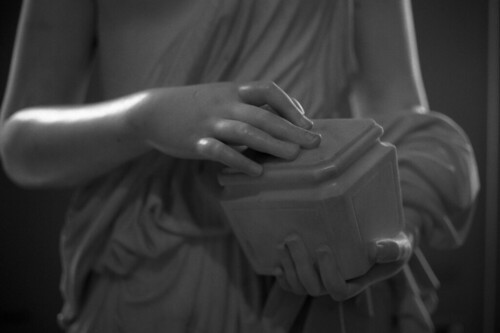 |
| Ilford Pan 100, rated 400, shot with Canon A-1 |
Ilford Pan 100 and Pan 400 data sheet (PDF)


















Hello.
ReplyDeleteI develope this film in kodak xtol 1+1. At box speed, film has very low contrast, is too flat and dull. Pushing it at 200 didn´t help, I can´t see any difference, or very low. But pushin to 400 do the job. Film got nice contrast and shadow areas are still OK in lower contrast scenes. I like your results in rodinal stand at EI400. I try it too and compare to 400 push in xtol.
Thanks for your comments - I haven't used Xtol, so I don't really know what its characteristics are; the shots in Rodinal at 400 are probably my favourite from the tests I made, but this may also be due to the subject matter and camera - I wasn't always testing like against like here.
Delete